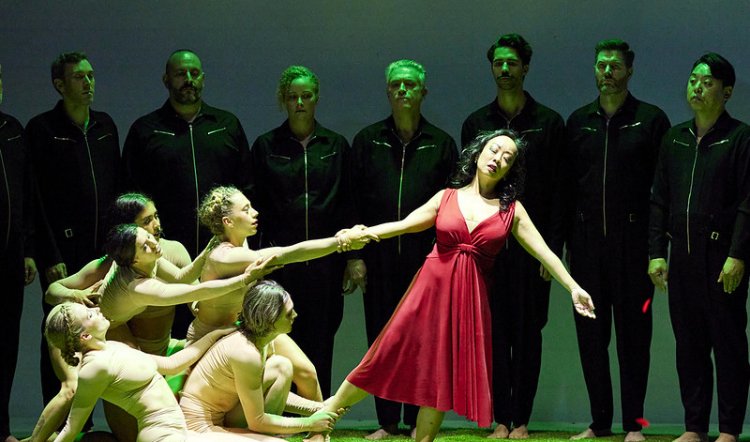Orpheus and Eurydice - Sydney Opera House (NSW)
Reviewed by Claira Prider
Joan Sutherland Theatre, Sydney Opera House
Until January 31st, 2024 Orpheus & Eurydice - Sydney Festival
Opera Australia joins forces with Circa to deliver opera like you've never seen it before in this contemporary and unbelievable reimagining of Gluck's Orpheus and Eurydice
Composed by Christoph Willibald Gluck with librettist Ranieri de’ Calzabigi, Orpheus and Eurydice retells the famous Greek myth of Orpheus. Premiering in Vienna in 1762, this was the first of Gluck’s ‘reform’ operas, referring to a style of opera that prioritised the drama of the story and lessened the rigidity of its’ recitative – da capo aria structure. First staged in 2019 by Opera Queensland, this production sees the collaboration of Opera Australia with Brisbane based circus company Circa to create a visually spectacular, multifaceted, genre blending performance.
The plot begins with Eurydice’s descent into hell, as an acrobat in a flowing red dress descends from the ceiling in a breathtaking and obscure routine. Made up of sparce, striking, bare white walls and floor, there is a single white metal bed frame with Orfeo strapped to it opposite a small, life-size metal glasshouse. The opening scenes are set in an outdated mental asylum where the female acrobats twirl, climb and flip around the stage in the same red dress that Eurydice was wearing - so everywhere he looks, Orfeo sees his dead wife.
Photos by Keith Saunders
Throughout the work, swirling mist and smoke projects onto the back wall of the set along with a projected birds-eye view of Eurydice as she lays lifeless on the floor of the glasshouse. Acrobats swirl around the stage, extending the misty, smoky atmosphere and creating a human chain between Orfeo and Eurydice. Libby McDonnell’s costumes reinforce the bleak hellscape with a colour palette of only black, white, and red which is also reflected in the set and lighting design. Alexander Berlage’s lighting embraced the use of spotlights to highlight the distance between Orfeo and Eurydice, and at one point, had a circus performer roving around the stage, spotlighting from ground level projecting their shadows onto the wall. Strobe lighting is used to heighten Orfeo’s nightmarish hell as well as red lights that represent Eurydice.
Unlike regular surtitle projections, Boris Bagattini’s digital projections saw the English translation of the Italian text projected directly onto the back wall of the set, moving, swirling, and dissolving, weaving the text physically closer to the singers so you don't have to look away so much to read the translation. Yaron Lifschitz, Bridie Hooper and Circa Ensemble’s choreography was all consuming, making superb use of shapes and layers.
Soprano Cathy-Di Zhang couldn’t perform the role of Eurydice on opening night due to illness, so Opera Australia Chorus member Sandy Leung stepped in last minute making for an exceptional main stage debut. Her tone was rich and honey like and she showed brilliant control on the softer higher passages while adapting well to the choreography requirements. French counter-tenor Christopher Dumaux shone as Orfeo, with a very resonant and focussed, brassy tone. He delivered much of his singing from the back half of the stage which at times felt like some of his sound was being lost up in the roof above the stage, however his magnetic, tortured embodiment made his performance readable from start to finish. Under the baton of Dane Lam who also conducted the Queensland production, the opera is supported by the Australian Opera Orchestra and the Australian Opera Chorus.
While the circus performers were spectacular and breathtaking, they could have been used more sparsely so not to completely dominate the music. The Circa performers mirrored the singer’s plot; expertly translating the libretto into human movement, however said translations sometimes did a disservice to the music. In a moment when a bereft Orfeo is singing of his grief and despair in not being able to find his wife, audience members were gasping and cheering at the daring and unbelievable shows of strength and agility happening on stage as well as erupting into applause mid act. There are exquisite moments where the physical performance enhances and amplifies the opera, however also many moments where it competes with and detracts from the story and the music.
Opera companies are forever having to reinvent the way opera is presented to appeal to a contemporary audience, and collaborating with a world class circus ensemble is definitely an engaging and unique way to do that. Director, Choreographer and Set Designer Yaron Lifschitz (who is also the Artistic Director of Circa) brings this astounding and contemporary spectacle to life in the Joan Sutherland Theatre as a part of Sydney Festival 2024.























